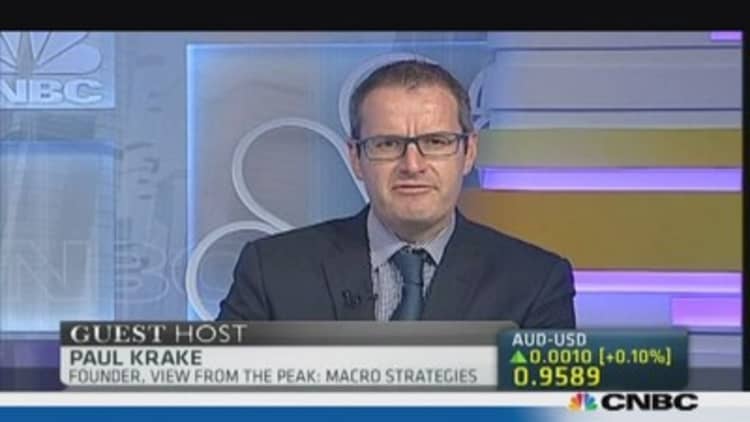
As the S&P 500 continues to post record highs, one strategist told CNBC the index still has substantial upside as tapering expectations get pushed out as far June.
The S&P 500 closed at a fresh record high of 1,759 on Friday, lifted by a group of positive earnings results. The index has gained over 23 percent this year, demonstrating that investor appetite for equities remains strong, despite the 16-day partial U.S. government shutdown and the debt ceiling debate.
Paul Krake, founder of View from the Peak:Macro Strategies, said the delay of tapering means corporations are now in a strong position to thrive, readying the index for a sharp rally.
(Read More: S&P 500 to rise another 100 points: Piper Jaffray)
"I can make the argument that tapering [won't] begin until June and that's somewhere around $700 billion's worth of assets that need to be purchased by the Federal Reserve between now and then and that will drive stocks sharply higher," said Krake.
According to Krake, if the Fed keeps interest rates at 0 percent for the next two years, as it has indicated in its guidance, this will keep funding costs for companies at extremely low levels. Cheaper funding costs mean corporations can enjoy healthier returns, he said.
"Given the outlook for historically low funding rates, the S&P 500 looks some 15 percent undervalued, 20 percent from October lows," added Krake, who has increased his exposure to equities in his absolute return portfolio from 50 percent to 80 percent on this bullish view.
"Is it a stretch to say that the S&P will trade at one standard deviation over its 20 year mean? That would equal 18.7 times 2014 earnings, which would put the S&P north of 2,050 – I don't think that's a stretch," he added.
(Read More: Cramer's game plan: Earnings surprises ahead?)
Krake also pointed out that the resilience of investors, in spite of the recent political impasse in Washington and the threat of a credit default, demonstrates that investors refuse to be rattled.
"Liquidity is the fundamental driver of all this, if you take a step back and look at what happened in Washington DC,equity markets didn't care about a default… they rallied in spite of it," said Krake.
The S&P 500 gained 2.3 percent over the course of the 16-day partial shutdown which began on October 1.
(Read More: As US stocks near high, it may be time to cherry pick winners)
He also dismissed any concerns about slowing growth in the rest of the global economy.
"The naysayers will come in and say global growth is stagnant, economic growth is anemic. The reality is that this is the first year since 1995 that we've had simultaneous growth in China, Europe, the U.S. and Japan. Yes, it's slow but valuations aren't stretched," he added.
However, Krake added that once the Fed does begin its tapering program, the S&P 500 will see a 10-15 percent correction following the announcement. However, until this happens, he said equities will remain extremely attractive.
—By CNBC's Katie Holliday: Follow her on Twitter @hollidaykatie


